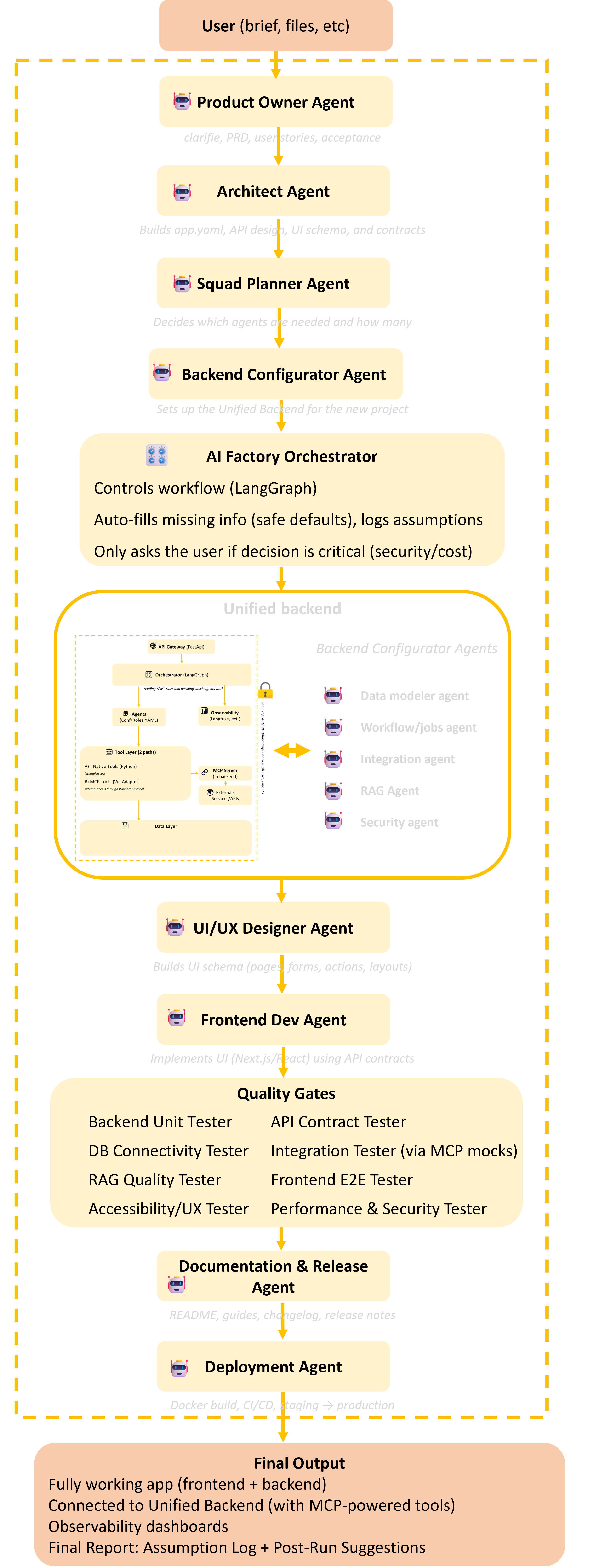Executive summary
- AI Factory = Unified Backend (shared APIs, data, tools) + Automation Layer (orchestrator + agents).
- Autonomous multi-agent system: from user intent & sketches to production SaaS.
- Continuous evaluation loops and observability for reliability, cost, and trust.
Core Architecture (Unified Backend + Automation)
The Factory couples a Unified Backend (APIs, DBs, vector stores, files, auth, observability) with an Automation Layer that coordinates specialized agents. Three roles structure the system: the Orchestrator, Worker agents, and Platform services for state and memory.

Coordinates workflows, manages dependencies and tools, enforces policies and quality gates.
Specialists for modeling, coding, integration, testing, deployment, and docs.
Shared runtime: data stores, vector memory, queues, and telemetry.
User Interaction & Agent Chain
You brief the Product Owner Agent in natural language and can share sketches, wireframes, or workflow diagrams.
The Architect converts this into app.yaml (models, APIs, roles, UI schema).
The Squad Planner selects agents and ordering.
- Chain: User → PO → Architect → Squad Planner → Backend Configurator → Orchestrator → (Data/Workflow/Integration/RAG/Security/Backend QA) → UI/UX → Frontend Dev → Testers → Deploy → Runtime agents.
- At key points (cost, data, security), the Orchestrator pauses to confirm decisions with you.
Automation Layer & Execution Flow
- Intent & Context — capture user goal, data constraints, and any sketches/workflows.
- Planning — PO + Architect produce
app.yaml; Squad Planner defines the agent execution plan. - Environment — Backend Configurator prepares the Unified Backend (APIs, data stores, auth, observability).
- Orchestrated Execution — the Orchestrator runs coordinated multi-agent workflows with tools, dependencies, and checkpoints.
- Evaluation Gates — self-checks, contract tests, cross-validation, and benchmarks; only validated outputs move forward.
- Product Assembly — generated code, APIs, UI, jobs, and configs are assembled as an application on the Unified Backend.
- Runtime & Operations — once live, runtime agents operate with events, APIs, and vector stores, while observability monitors cost, latency, and quality.

Artifacts & Contracts
The Factory maintains explicit artifacts at each stage: app.yaml (design), an execution plan (agents & order), test contracts (OpenAPI/GraphQL, data), and deployment metadata.
These keep agents aligned and make evaluation reproducible.
Evaluation & Observability
- Agent self-checks and contract tests for APIs and data.
- Regression suites and synthetic datasets for repeatable validation.
- Unified telemetry for latency, cost, performance, and accuracy.
Research & Innovation
Ongoing R&D enhances multi-agent coordination, evaluators, and graph-aware learning — continuously merged so every new app benefits from the latest improvements.
Security & Operations
- Tenant isolation, least-privilege roles, and full audit trails.
- Encrypted secrets and environment-specific configuration.
- Automated deploy/rollback via SRE agents with live observability.
Frequently Asked Questions
What is the AI Factory?
The core platform combining a Unified Backend with an Automation Layer to autonomously build, test, and deploy apps using specialized agents.
How do users interact?
Via the PO Agent in natural language (with optional sketches). The agent chain then executes the plan with user confirmation on key choices.
Can teams extend it?
Yes — you can add domain agents and connect data sources to shared services and workflows.
How is quality ensured?
Evaluation loops at each stage, contract tests, benchmarks, and unified telemetry for reliability and cost control.
How are agents validated?
Each agent runs under supervision of the Orchestrator and is monitored through metrics, tests, and traceability logs.
Can humans join the chain?
Yes — human checkpoints can be injected into the chain, typically for design, review, or domain validation stages.
Is it compatible with external APIs?
Absolutely — Integration Agents connect safely through retries, rate-limit handling, and contract validation.
What kind of applications can be built?
Any data-driven SaaS: analytics, monitoring, research tools, or AI-powered assistants — all built with the same core principles.
